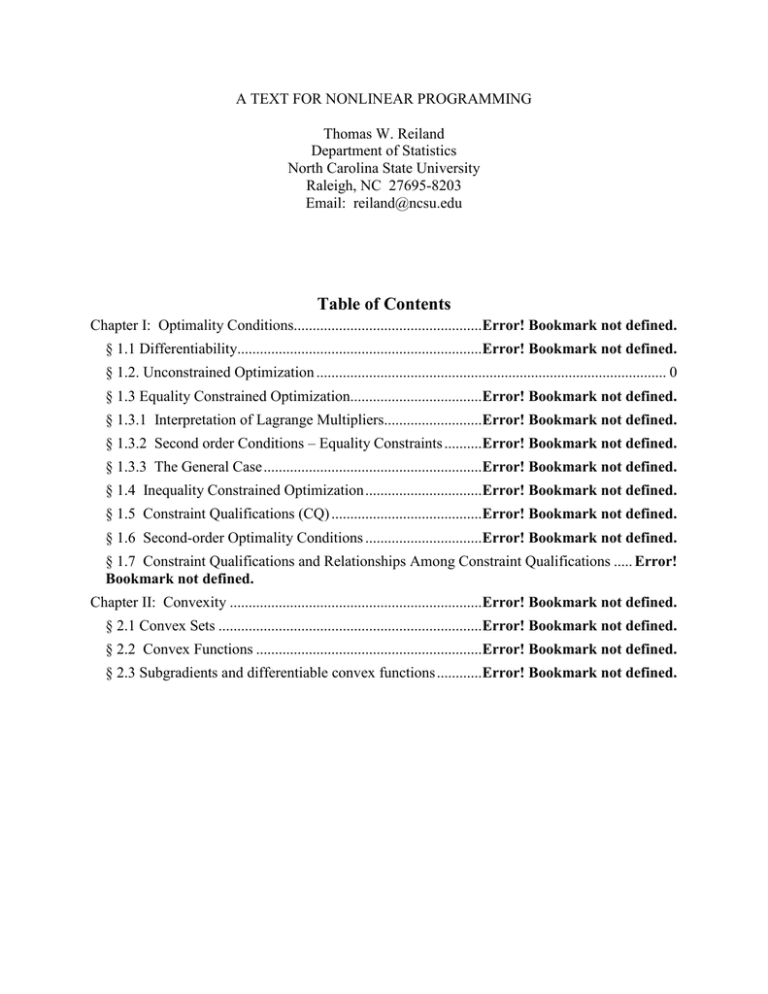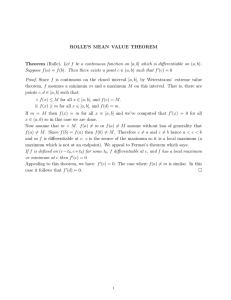1.2 Unconstrained Optimization
advertisement

A TEXT FOR NONLINEAR PROGRAMMING
Thomas W. Reiland
Department of Statistics
North Carolina State University
Raleigh, NC 27695-8203
Email: reiland@ncsu.edu
Table of Contents
Chapter I: Optimality Conditions..................................................Error! Bookmark not defined.
§ 1.1 Differentiability.................................................................Error! Bookmark not defined.
§ 1.2. Unconstrained Optimization ............................................................................................. 0
§ 1.3 Equality Constrained Optimization...................................Error! Bookmark not defined.
§ 1.3.1 Interpretation of Lagrange Multipliers..........................Error! Bookmark not defined.
§ 1.3.2 Second order Conditions – Equality Constraints ..........Error! Bookmark not defined.
§ 1.3.3 The General Case ..........................................................Error! Bookmark not defined.
§ 1.4 Inequality Constrained Optimization ...............................Error! Bookmark not defined.
§ 1.5 Constraint Qualifications (CQ) ........................................Error! Bookmark not defined.
§ 1.6 Second-order Optimality Conditions ...............................Error! Bookmark not defined.
§ 1.7 Constraint Qualifications and Relationships Among Constraint Qualifications ..... Error!
Bookmark not defined.
Chapter II: Convexity ...................................................................Error! Bookmark not defined.
§ 2.1 Convex Sets ......................................................................Error! Bookmark not defined.
§ 2.2 Convex Functions ............................................................Error! Bookmark not defined.
§ 2.3 Subgradients and differentiable convex functions ............Error! Bookmark not defined.
1.2 Unconstrained Optimization
1.2-1
§ 1.2. Unconstrained Optimization
Consider the following problem:
Max f ( x), x E n , f has continuous 1st order partial derivatives (i.e. differentiable)
Theorem 1.1 Suppose there is a direction d E n such that f ( x0 )T d 0 . Then there exists
0 such that for t , 0 t , f ( x0 td ) f ( x0 ) .
f ( x 0 td ) f ( x 0 )
0
t 0
t
By the definition of a limit, there exists 0 for 0 t
f ( x 0 td ) f ( x 0 )
0
(eventually this is positive)
t
Hence for any t, 0 t , then f ( x0 td ) f ( x0 ) 0 . QED.
Proof: f ( x 0 )T d lim
Corollary 1.1 If x is a finite local maximum of f ( x) then
f ( x ) 0
(1)
Proof: Suppose f ( x ) 0 ; choose d f ( x ) . Then f ( x )T f ( x ) 0
Theorem 1.1 implies that there exists 0 such that
f ( x d ) f ( x ) for 0 #
This contradicts the fact that x is a local maximum. QED.
Remark: Moreover, (1) holds if x is any local optimum of f ( x) . (1) is a necessary
condition to identify candidate points and is not sufficient to guarantee optimality. These
candidates are often called critical (stationary) points and include local max/min points, global
max/min points, and saddle points.
Example 1-3: f ( x) x3 , f ( x) 3x 2 , 3x 2 0 x 0 but this is only an inflection point.
Theorem 1.2 Let the function f ( x), x E n , have continuous 2nd order partial derivatives.
f ( x ) 0
If
(2)
n
And zT 2 f ( x ) z 0 , z E , z 0 ( 2 f negative definite at x )
(3)
Then x is a local maximum point of f. If the inequality is reversed in (3), then x is a
local minimum of f. Together, (2) and (3) are sufficient conditions.
Proof: Since f is twice differentiable at x , for each x E n
1
2
f ( x) f ( x ) f ( x )T ( x x ) ( x x )T 2 f ( x )( x x ) x x ( x ; x)
()
2
where ( x ; x) 0 as x x
Suppose x is not a local maximum point
1.2 Unconstrained Optimization
For
1.2-2
1
1
0 , k is a positive integer, there exists a vector xk such that x xk and
k
k
f ( xk ) f ( x )
Consider the sequence {xk } , k 1, 2,..., ; since f ( x ) 0 and f ( xk ) f ( x ) , and
x x
denoting d k k
Then () implies the following:
xk x
()
f ( xk ) f ( x )
xk x
2
(x x )
1 ( xk x )T
f ( x ) k
( x ; xk )
2 xk x
xk x
Since f ( xk ) f ( x ) , then this must be positive.
f ( xk ) f ( x ) 1 T
d k f ( x )d k ( x ; xk ) 0
()
2
2
xk x
But d k 1 for every k and so there exists a convergent subsequence of {d k } , say {d k } ,
that converges to d where d 1 . Since all d k ’s are in the unit ball in E n which is compact;
every sequence in a compact set S has a convergent subsequence which converges to an element
in S.
Since ( x ; x) 0 as k , implies the following:
lim
k
k
1 T
1
d k f ( x )d k ( x ; xk ) d T f ( x )d 0 #
2
2
This contradicts (3) so x must be a local max. QED.
Note: “ 0 ” in (3) not adequate.
Example 1-4: f ( x) x3
f ( x) 3x 2 , 2 f ( x) 6 x
At x 0 , f ( x) 0 and zT f ( x ) z 0 but x is not a local maximum.
Example 1-5: max f ( x) x 4
f ( x) 4 x3 0 x 0 is a candidate point.
2 f ( x) 12 x 2
2 f (0) 0
So zT 2 f (0) z 0 and the sufficient conditions from
Theorem 1.2 are not satisfied (too strong in this case) even
though 0 is a maximum point.
Example 1-6: min f ( x1 , x2 ) (2 x1 x2 ) 2 ( x2 1) 2
1.2 Unconstrained Optimization
1.2-3
8 x1 4 x2
2(2 x1 x2 )2
f ( x)
2(2 x1 x2 )(1) 2(x 2 1) 4 x1 4 x2 2
8 4
2 f ( x)
4 4
1
x1*
8 x1 4 x2
Critical Points f ( x)
2
0
*
4 x1 4 x2 2
x2 1
1
f ,1 0
2
8 4 z1
2
2
z2
z 8 z1 4 z2 8 z1 z2 0 z 0
4
4
2
*
Therefore, x is a local (and global) minimum of f.
z1
Example 1-7: min f ( x1 , x2 ) ( x1 x2 ) 2
2( x1 x2 )
f ( x)
0 x1 x2
2( x1 x2 )
2 2
1
so z T 2 f ( x) z 2 z12 4 z1 z2 2 z22 0 ; this equals 0 at z
2 f ( x)
2 2
1
So sufficient conditions are not satisfied even though x1 x2 provides minimum.
Special Cases:
1) One Variable: Given f : E1 E1 , x is an unconstrained local maximum (minimum) of
f ( x )
2 f ( x )
0 and
0 (> 0).
x
x 2
Suppose f ( x ) 0
i. If the first nonzero derivative of f is of odd degree, then x is neither a local maximum
or minimum.
f ( x ) if
ii. If the first nonzero derivative of f is positive and of even degree, then x is a local
minimum.
iii. If the first nonzero derivative of f is negative and of even degree, then x is a local
maximum.
2) Two Variables: Given f : E 2 E1 , x is an unconstrained local maximum (minimum) of
f ( x ) f ( x )
2 f ( x )
2 f ( x ) 2 f ( x ) 2 f ( x )
0,
f ( x ) if
0
(>
0),
and
0
x1
x2
x12
x12
x22
x1x2
Theorem: The symmetric matrix S ( si j ) nn is positive definite if and only if s11 0 and all
leading minors have determinant greater than zero.
e.g.
s11
s21
s12
0,
s22
, S 0
1.2 Unconstrained Optimization
1.2-4
Theorem: The symmetric matrix S ( si j ) nn is negative definite if and only if s11 0 and
s11
s12
s21
s22
s11
s12
s13
0, s21
s31
s22
s32
s23 0,
s33
, (1)n S 0 .
Theorem 1.3 2nd Order Conditions
If f is twice continuously differentiable and if x is a local maximum of f, then
(4)
f ( x ) 0
T 2
And z f ( x ) z 0 z
(5)
If
f ( x ) 0
(6)
And
z f ( x) z 0
(7)
T
2
For every x in some open ball BS ( x ) around x and z , then x is a local maximum. If the
inequalities in (5) and (7) are reversed, then the theorem applies to a local minimum. Conditions
(4) and (5) constitute necessary conditions while (6) and (7) describe sufficient conditions.
Theorem 1.4 Let f be twice continuously differentiable.
If f ( x ) 0
(8)
And z f ( x) z 0, z, z 0, x x in open ball around x
(9)
Then f has a strict local maximum at x . Reversing the inequality in (9) implies x is a strict local
minimum of f.
T
2
Example 1-8: f ( x) x 2 p , p is some positive integer
f ( x) 2 px(2 p 1) 0 at x 0 , satisfying necessary conditions in Corollary 1.1.
2 f ( x) 2 p(2 p 1) x 2( p 1)
For p 1 : 2 f ( x) 2 x0 2 0 , at x 0 , sufficient conditions met from Theorem 1.2
for local minimum.
For p 1 : 2 f ( x) 0 so sufficient conditions in Theorem 1.2 for a local minimum at
x 0 are not satisfied, yet f has a minimum at x 0 . Using Theorem 1.3, at x 0 , all
conditions for a local minimum (both necessary and sufficient) from Theorem 1.3 are satisfied.
Necessary Conditions:
f ( x ) 2 p( x ) 2 p 1 0 at x 0 satisfies (4)
2 f ( x ) 2 p(2 p 1)( x )2( p 1) 0 at x 0 so zT 2 f (0) z 0 z satisfies (5)
Sufficient Conditions:
f ( x ) 0 at x 0 satisfies (6)
1.2 Unconstrained Optimization
1.2-5
2 f ( x) 2 p(2 p 1)( x) 2( p 1) so zT 2 f ( x) z 0 in any neighborhood of x 0
which satisfies (7)
In fact, by Theorem 1.4, x 0 is a strict local minimum since zT 2 f ( x) z 0 x 0 .



